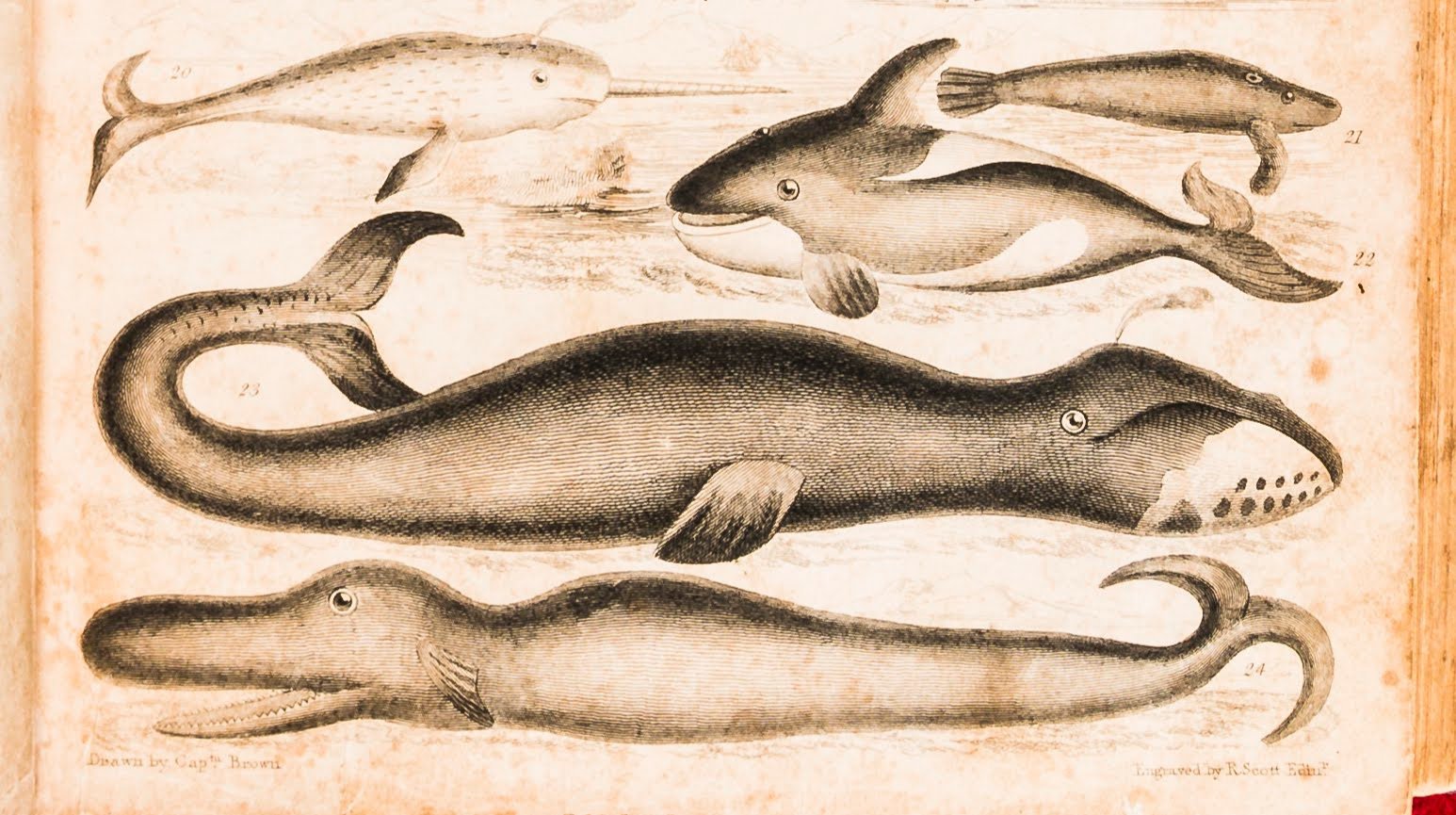Weird whales: the top 6 whale illustrations in the Australian Museum Research Library
Although scholars have been interested in whales for thousands of years, their attempts to illustrate them haven't always been successful.
In early-modern publications, scientists often mixed fact with fiction, and whales were frequently included in scientific works alongside imaginary sea monsters. While later scientists were more factual in their research, they still found it nearly impossible to illustrate whales accurately. Natural history illustrators had to rely on carcasses of beached whales as their models, producing images that were inaccurate, bloated, and often downright strange.
As one of the largest collections of published natural history in Australia, the Australian Museum Research Library has many of these weird and wonderful whales tucked between pages. We’ve compiled a list of the top six weirdest whales in our collection to share with you.
1. An "orca" from 1553

Woodcut of an "orca" from Libri de piscibus marinis, in quibus ver piscium effigies express sunt by Guillaume Rondelet, 1553-1555.
Image: Nick Langley© Australian Museum
This unsavoury looking “orca” features in the oldest book in the Australian Museum Research Library. Libri de piscibus marinis, published in parts between 1553 and 1555, was the masterwork of anatomist and naturalist Guillaume Rondelet. While Rondelet based most of his descriptions of marine animals on his own first-hand observations and dissections, he still included some questionable species in Libri de piscibus marinis which he hadn’t personally seen. At least one whale species he described has never been verified, and others, like this orca, look nothing like what we know an orca to be today.
2. A tentacled monstrosity from 1638

Woodcut of a "Monstrosæ balænæ" in De piscibus libri v. et de cetis lib. unus [1638 edition], Ulisse Aldrovandi, 1638.
Image: Abram Powell© Australian Museum
This tortured looking beast appears in Ulisse Aldrovandi’s massive marine encyclopaedia De piscibus libri v. et de cetis lib. unus, first published in 1613 (the Library holds the 1638 addition). Like many zoologists of this era, Aldrovandi was undiscerning when it came to the sources of his descriptions, and many creatures he described were fantastical, such as sea serpents and mermen. Others, such as the whale depicted here, are so anatomically incorrect that it's doubtful whether Aldrovandi ever saw a real whale. In one respect, Aldrovandi’s classification of marine animals was quite forward-thinking for his time – unlike his peers, he distinguished fish (piscibus) from whales (cetis) and other marine mammals.
3. A happy harpooned sperm whale from 1804

"Cachalot macrocephale" in Histoire naturelle des cétacés by Comte de Lacépède, published in Paris, 1804
Image: Nick Langley© Australian Museum
This sperm whale, from Histoire Naturelle des Cétacés by the Comte de Lacépède, looks far too cheerful considering its circumstances! Many whales in the 18th and 19th centuries were illustrated with harpoons and other weapons piercing their sides, a strange concession to realism compared to their bulbous shapes and unnatural expressions. A favourite on Pinterest and other image-sharing sites, Lacépède’s sperm whale has remained very popular to this day, and is now available on t-shirts, mugs, and even bedspreads.
4. A ghostly beluga from 1836

© Australian Museum
This Beluga whale from De l'histoire naturelle des cétacés by Georges-Frédéric Cuvier bears a striking resemblance to Casper the Friendly Ghost. Like Lacépède’s whale, it’s sporting a harpoon in its side. Despite its distorted illustrations De l'histoire naturelle des cétacés was a landmark publication of its time, correcting centuries of errors about cetacean natural history. Unlike other scientists, Cuvier was self-aware about his difficulties in portraying whales and was quoted as saying: “Figures drawn from whales when floating freely, would be in a condition to inspire more confidence, but if such figures are possible, we believe that science, as yet, does not possess any.”
5. Slippery looking dino-whales from 1840

Various whales in A History of the Earth and Animated Nature by Oliver Goldsmith, 1840 edition.
Image: Abram Powell© Australian Museum
These sleek characters first appeared in Oliver Goldsmith’s A History of the Earth and Animated Nature in 1774. Many subsequent editions were published over the next century and by the time the 1879 edition was released, these whales were replaced by a far more accurate depiction of a sperm whale. Luckily, the Australian Museum Research Library holds the 1840 edition, which still features these strange, dinosaur-like creatures.
6. A chunky whale battle from 1843

"The Spermaceti Whale", in The Naturalist’s Library, Volume 7: Mammalia. Whales, edited by William Jardine. 1843 edition
Image: Nick Langley© Australian Museum
These two lumpy-looking whales appear in the 1843 edition of the natural history encyclopedia The Naturalist's Library. Early Victorian illustrations of whales were often action images of fierce battles between whalers and their prey, reflecting one of the only activities where humans were able to see live whales up close. These encounters were fleeting and chaotic, which left artists struggling to recreate them after the fact. This resulted in unusual perspectives and often-comical proportions between the whales and their human hunters.
In the mid-nineteenth century, whalers developed a process to create careful line drawings of marine animals based on measurements taken at sea. Their efforts resulted in far more accurate illustrations of whales, and marked the end of the weird whale era in scientific publication.
Discover the giants of the ocean in the Australian Museum’s summer blockbuster Whales | Tohorā. Must close 28 April!
References and further reading
- Roque, Ana Christina and Wright, Andrew J. Proceedings of the ECS Workshop: From Nature to Science: Scientific Illustration on Marine Mammals Throughout the Centuries. Old Challenges and New Perspectives, held at the European Cetacean Society’s 27th Annual Conference, Setúbal, Portugal, 6th April 2013. European Cetacean Society, ECS Special Publications Series, 2013, https://projectofct.files.wordpress.com/2014/02/ecs2013_specpub56_illustration_web-2.pdf
- Romero, Aldemaro. “When Whales Became Mammals: The Scientific Journey of Cetaceans From Fish to Mammals.” New Approaches to the Study of Marine Mammals, edited by Aldemaro Romero and Edward O. Keith, IntechOpen, 2012, https://www.intechopen.com/books/new-approaches-to-the-study-of-marine-mammals/when-whales-became-mammals-the-scientific-journey-of-cetaceans-from-fish-to-mammals-in-the-history-o

